Something big is happening in Portland: We’re entering an era where streets are seen as places for much more than private vehicle travel and storage. An era where the public right-of-way can reach its potential as a thriving place that adds to the vitality and energy of our city.
Livable streets are in Portland’s DNA, but a combination of factors have recently come together to energize and formalize the movement and soon it could be enshrined in official city policy.
The City of Portland Bureau of Transportation is in the process of selecting a private firm to develop a “Livable Streets Strategy.” According to the request for proposals (PDF), the city is, “looking at innovative ways to open Portland’s streets, parking spaces, plazas, and alleys to a range of events, programming, and physical infrastructure that reinforce the idea that public streets are public places to be enjoyed by all ages and abilities.”
We knew something special was afoot ever since Transportation Commissioner began literally jumping up-and-down and chanting “Bet-ter Block! Bet-ter Block!” at the opening of the Better Naito project in 2015. The three-way romance between City Hall, the Bureau of Transportation and Better Block PDX has helped create the political and public momentum neede to re-think how we use our streets. But it didn’t start there.
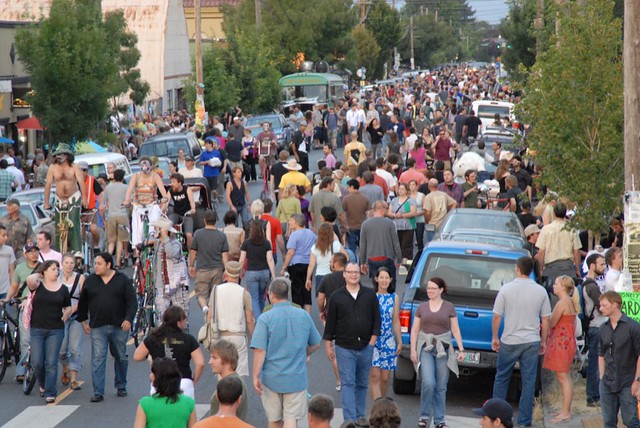
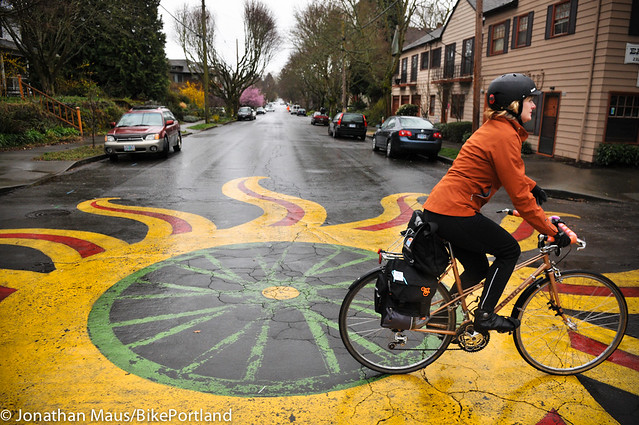
For many years PBOT has been a willing supporter and national pioneer of livable streets-related projects and programs. Have you ever attended or organized a block party on a local street? Or sat in a “street seat” outside your favorite cafe? I know many of you have parked in an on-street bike corral. Or how about those huge colorful paintings that adorn intersections throughout the city? Ever seen one of those? All of those things are officially sanctioned by our city government.
“PBOT wants to create unique and exciting opportunities for the public to take advantage of Portland’s right of ways.”
— From the city’s RFP
Programs that allow citizens to change how streets are used are so popular that the city has trouble keeping up with demand. As we reported yesterday, even though the bike corral program is well-established there’s still a waiting list for businesses that want in on it. And as we’ve seen with upstart activist groups like the anonymous Portland Transformation, some people aren’t willing to wait.
Instead of staying locked up in their cubicles and trying to hold back the dam, PBOT is riding this wave of citizen-initiated demonstration projects. In an era of limited budgets and staff capacity it makes complete sense. Their unprecedented partnership with Better Block PDX — a group that has recently transformed Naito Parkway and Northeast Broadway — has cemented PBOT’s role as more of a facilitator and not just an initiator.
When nonprofit Oregon Walks came to PBOT with the idea of a walking event styled after Sunday Parkways, the outcome was Oregon Walkways. PBOT (and several other organizations) are key partners, but Oregon Walks is the main organizer and host.
This is a sign of things to come.
With their Livable Streets Strategy, PBOT wants to create an umbrella for all existing and new placemaking programs and projects. Currently the programs are scattered throughout the bureau — each one with a different staff person as the citizen liaison. This is not only cumbersome from management standpoint, but it also leads to a lack of unified branding and consistent public messaging. “PBOT wants to create unique and exciting opportunities for the public to take advantage of Portland’s right of ways,” PBOT writes in their RFP. “The final Strategy is to provide a programmatic and regulatory framework that will inform the planning, permitting, and management of community use projects in the right-of-way.”
Advertisement
PBOT will still handle livable streets programs, but they want the community to take a larger role. The firm that wins the project (estimated to have a budget of $100,000 to $130,000) will help the city identify opportunities to make that happen.
Say for instance a local business district wants to repurpose an unused portion of road and create a public plaza with tables, chairs, and walkways (an actual example in the RFP); the consultant firm would would devise a process to make that possible.
Also in the RFP is a call for the selected firm to identify six pilot projects for “immediate implementation.” Details are scant so far but the RFP says all deliverables are due by September 30th of this year.
Why is this happening now? It’s a combination of things. Paramount among them is that PBOT has undergone a quiet transformation in the past two years or so. For the first time in at least the past decade (the time I’ve been watching), nearly every major manager at PBOT (at least all the ones that matter) — all the way up to and including Director Leah Treat and Transportation Commissioner Steve Novick — support livable streets. Having people at key positions who say “yes” to new things is a big deal. In the past there was always at least one stick-in-the-mud who would ruin the party.
Speaking of sticks-in-the-mud, roadways are often a battleground of competing uses and debates about how to use them are fodder for controversy. Empowering citizens and businesses to initiate projects themselves is a smart way for PBOT to avoid some of the heat.
It’s also likely that the City of Portland is tired of hearing about how they’re falling behind other cool cities when it comes to innovative livable streets projects. With the aforementioned staff now in place, and a new — much more progressive — mayoral administration on the horizon — they might feel like it’s go time.
Another factor? This August Portland will host the International Open Streets Summit and the City probably wants to make sure they have some exciting news to share.
We can’t wait to see what this summer brings. We’re so excited in fact that we’ve made open streets the theme of our next Wonk Night. Please join us next Wednesday June 1st at Lancaster Engineering/Street Labs where we’ll talk with the people leading this new charge and you’ll learn all the latest insights.
— Jonathan Maus, (503) 706-8804 – jonathan@bikeportland.org
Our work is supported by subscribers. Please become one today.


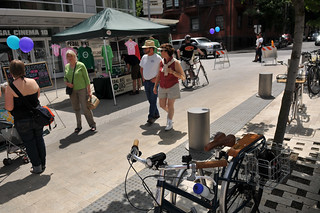
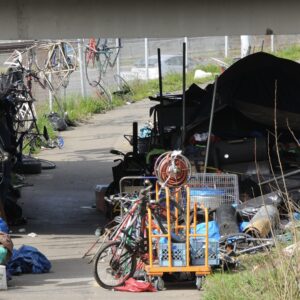


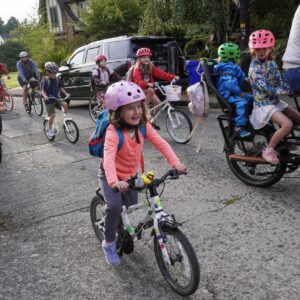
Thanks for reading.
BikePortland has served this community with independent community journalism since 2005. We rely on subscriptions from readers like you to survive. Your financial support is vital in keeping this valuable resource alive and well.
Please subscribe today to strengthen and expand our work.
Wow. Didn’t see this coming. This makes me really optimistic, like the city is actually listening.
Is there any indication of who applied to the program? I’m sure at least one progressive engineering firm did, but curious who else.
Not that surprising. Examples:
13th at Holman
Klickitat, 23r-24th
Festival streets in Chinatown
Director Park
No, I’m wondering what engineering firms applied.
no,
examples of it coming provided.
Ah. So I should have seen this coming because Director Park was built seven years ago and Klickitat was done three years ago.
I see Portland rejecting cars like a transplant patient can reject a new organ. Feature this, as James Ellroy would say, we have a city core that’s so 19th century that there are still hitching rings in the curbs in a number of neighborhoods, many residential streets that feel too narrow for two cars to pass each other. This isn’t a city that could be made truly car friendly without bulldozing and rebuilding huge swaths–it’s good to see spaces being reposessed from car use.
I’ll be first to state the obvious: when will the majority of the Park Blocks cease to be a four lane continuous strip of car parking/private car storage, plus two traffic lanes?
Is this not the lowest hanging fruit out there? What are your predictions to it’s transformation? Sadly, I remain pessimistic. 🙁
Great question! There has been talk about the park blocks becoming carfree for years now but no one has ever led the charge and even turned the talk into a real proposal.
Based on the story above and PBOT’s new direction… I’d say it might finally happen if a group of nearby residents and business owners got together and proposed the idea to the city. They could try it out with an event or two and then.. who knows?
This is what frustrates me. The nearby residents and business owners are not the only ones who would benefit from an improvement. So why should the idea only come from them? Any user of the space is a potential stakeholder as well.
adam,
i totally hear what you’re saying. i was just shooting from the hip. i agree that transportation project discussions often marginalize the voices of people who use the facility but who might not live/own property directly adjacent to it. That being said, you can be frustrated, but the reality is that the first thing the city will do is look to see if the idea is supported locally. If it isn’t they won’t do it. end of story. SO… if you wanted something to happen you could help build a coaltion and/or be part of the coalition that asks for it – whether you live or work adjacent to it.
And FWIW you’ll notice when I make calls to action about a specific project or policy, I make a point to write, “If you live, work OR RIDE in xyz neighborhood…”.
No, I totally get it. It’s just frustrating that the city implies that the “owners” of the neighborhood’s public land are the people who live and own a business nearby. The parks and streets belong to everyone. We are all collectively owners of every public space in the city. This is especially true downtown, where users likely far outweigh “owners”. If the city doesn’t spend any effort convincing people that car-free spaces will work, then frankly, it likely won’t happen. There is guaranteed to be significant opposition, and it’s up to the city to stand up to it.
In Vancouver BC, there was significant opposition from local businesses to the downtown bikeways, but the city built them anyway. After seeing the facilities go in, the businesses have changed course are now asking for more. This is where a well-designed trial program can work, but it’s disappointing that we need everyone who PBOT considers to be a “stakeholder” on board to even start the trail project.
That being said, with even a little leadership, this program could be very successful as more and more people see the benefits of transforming our public spaces for people. I have high hopes that PBOT will succeed here and look forward to seeing some projects on the ground soon!
While it is true that much of the public space is held in trust for the use by the public, it is untrue that the city, corporate, ‘owns’ much of the right of way.
If this were true, the street vacation process would not exist, it would be called the street ‘selling’ process.
Most public rights of way are dedications required as a condition of land development (The citizens of Portland did not buy the land). Those dedications come from the adjacent fronting property, and if the right of way is no longer needed for public use it’s dedication can be vacated, and the land returned to that fronting property owner.
BTW, Portland had a car-free space downtown before, and like many across the nation it did not do what it was promised, so was repurposed. The European examples of car free zones I’ve seen are in much denser urban environments than Portland.
I hear you. But careful what you wish for. Valuing the transportation users over the nearby land owners is what brought us freeways running through our city. Certainly there are major differences in this analogy, but I think we have to carefully consider the local opinion.
Of course I’m not saying don’t include nearby land/business owners. I’m saying don’t exclusively include them. Perhaps it would make an even stronger argument if users of the adjacent public land (i.e. potential customers) were asking for better infra there too! As well as, we don’t want to end up with situations in NYC and Chicago where nearby homeowners were able to remove bike share stations from the sidewalk in front of their property for “being ugly”.
Or if not car free, why couldn’t the city try a variety of what could be called extreme car regulation–super-premium-priced parking meters, removal of a lane either direction, speed bumps and more lighted and signed crosswalks?
Glad to hear interest in this! Oregon Walks & Better Block will be partnering on Oregon Walkways: Connect The Park Blocks on August 20th (the same day as the Open Streets Summit!) to see what a pedestrian friendly park block area looks like. Like all of Better Block projects, the hope here is to start the conversation on re-imagining our streets. More details coming soon!
What is the history behind the PSU pedestrian area at the end of the South Park Blocks? That might be a good place to start. Especially with the insanely popular Saturday Market.
I live right by here and I actually usually cut over to Broadway or 10th after I get past Mill when I’m walking somewhere because I find crossing the Park Blocks, especially on Market, Columbia, and Jefferson, to be way too stressful.
TLDR: the PSU park blocks were pedestrianized after the Kent State Shooting protests, which had taken over those streets/blocks anyhow. You can read more on Wikipedia, I wrote most of it.
Those blocks aren’t “owned” by PSU, which leads to occasional oddities regarding school policy.
Does anyone else remember when there was no parking on the Park Blocks on the ‘interior’ of the streets [immediately adjacent the parks]? It was only about 6 or 7 years ago that they added the parking and we were told it was temporary, but never ended.
It really affected the feel of the park blocks, and made driving and cycling much tighter and less comfortable.
Agreed that the street crossings can use some calming, though the central crosswalks are pretty well respected in SW.
I actually don’t mind the parking, as anything that makes people drive slowly and more cautiously is a good thing in my view, but really, they should be completely pedestrianized.
There’s a lot of low-hanging fruit. The park blocks may be the lowest; park and 9th are both terrible to drive on and serve as nothing more than a linear parking lot.
Closing one or both of of the streets off to cars and turning it in to a cycle track wouldn’t take much more than some paint and signs. Signals at each named-street crossing at a pace of 10mph or so would make an awesome north-south bike artery that isn’t too close to naito and the waterfront to be redundant.
This sounds promising! Glad to see the city taking charge to improve streets. Are they taking suggestions from the public? I’ve got a few ideas (car-free NW 13th, bike plaza at 26th and Clinton, etc.). Getting everything under one roof should help streamline street transformations, too. PBOT could just come in with a toolbox of improvements instead of piece-mealing things from different departments. Nothing like hosting an international event to motivate cities to get things done!
As Portland becomes more dense, it only makes sense. From a pure mathematical capacity automobiles are a very inefficient and low volume way to move people around a densely inhabited environment. A three lane freeway with single occupant cars can only carry about 5000 people per hour. It only goes downhill from there with carrying capacity of a cars driving down single lane city streets is truly laughable. We can not continue to add people to Portland and Pretend to drive around in cars the way we did in the 1970’s. No matter how badly people want happy motoring to continue, the physics don’t work.
Ok, you try to move anything like a couch on a bike then, or how about large freight? Deliveries? I am sure business will love that.
That’s perhaps one out of 500 vehicles on the road.
Common myth and yet it seems to work fine in every city that has shut down their streets.
O,
Like this?
http://bikeportland.org/2013/02/01/portland-bike-move-breaks-record-gets-national-attention-82489
http://www.streetfilms.org/bike-move/
Many big trucks with lift gates carry a pallet jack or at least a hand-truck. An electric cargo scooter would roll deliveries right in the door.
There’s a lot of low-hanging fruit. The park blocks may be the lowest; park and 9th are both terrible to drive on and serve as nothing more than a linear parking lot.
Closing one or both of of the streets off to cars and turning it in to a cycle track wouldn’t take much more than some paint and signs. Signals at each named-street crossing at a pace of 10mph or so would make an awesome north-south bike artery that isn’t too close to naito and the waterfront to be redundant.
Natio is pretty high on the low fruit list too. it;s nearly dead at non-peak times, and during that time, it’s mostly bridge hoppers.
Bridge hoppers: I’ve seen that term used often in discussions here, but I don’t understand it. It brings to mind people doing circles across the river, but surely that can’t be the case. Can you explain what the term means, and why bridge hoppers are relevant to the topic? Thanks!
As I’m referring to it, it’s people trying to get around backed up bridges. For example, traffic on the Marquam is backed up so people leave I-5 to hop across on the Ross Island. Of course, it doesn’t take long for it to get backed up too so they drive down to the Hawthorne …rinse and repeat.
Then there is always the folks that try to beat the bridges when the boats come through as well.
Naito is practically an empty non-peak hours when there is no festival in town. There are very few businesses on it, there is no street parking, I strongly feel that between the Water Dr, and the Steel bridge should be closed to auto traffic, and the street more aesthetically paved with a cycle path. The paved road should remain and be the festival area (with a couple built in stages and such) which would free up the lawn for actual honest to gawd park-like activities. Most the project could likely be paid off by selling the street space between front and 1st for expansion and redevelopment.
What a nightmare for the people that have to conduct business in portland. Bike friendly roads lol.
Monorail monorail monorail!
– Car-free Portland. HUGE fiesta, everyone’s invited.
– Residential on-street bike parking
– Residential on-street pedestrian parking
What splendid ideas. This would shift the responsibility for street maintenance , the fees collected by parking meters to bicycle users which could be in the form of a license plate, paid parking slots, etc.
Me, I head to the Lloyd Center, local neighborhood businesses or suburbs to spend my money. The suburbs will be come even more attractive when I fill my car once every couple of weeks outside the city, when I go a relatives, or some other errand outside Portland. Why go downtown in 2020. By then the trucks that deliver the merchandise people go to downtown to buy won’t be able to deliver the goods.
As a native, I’ve pretty much abandoned the downtown, and am so fed up with the recent “feel good” mayors and their lack of fiscal responsibility, I can’t wait for a change of management.
I take MAX, ride the bus and walk a lot, but a smaller town is looking better all the time.